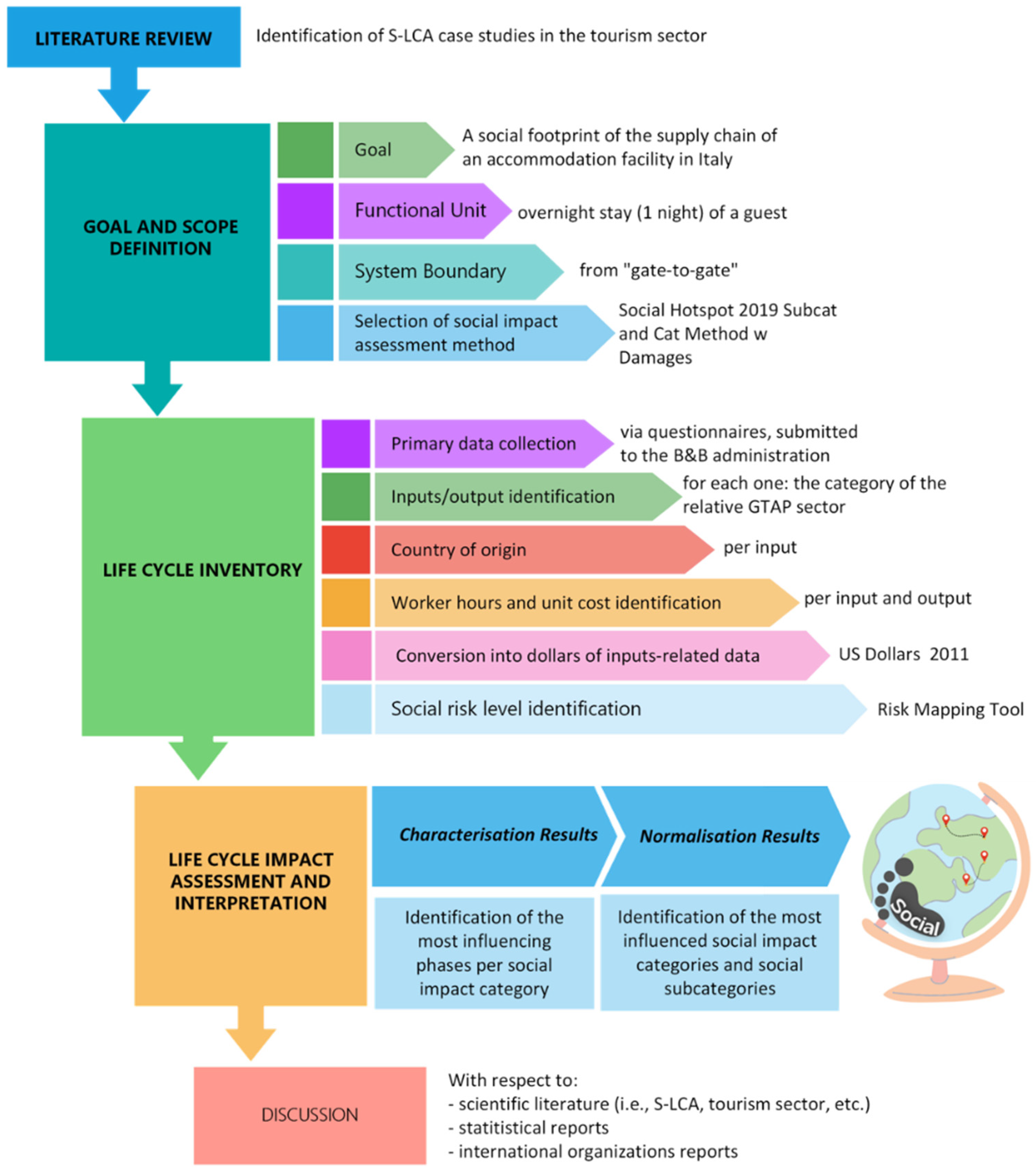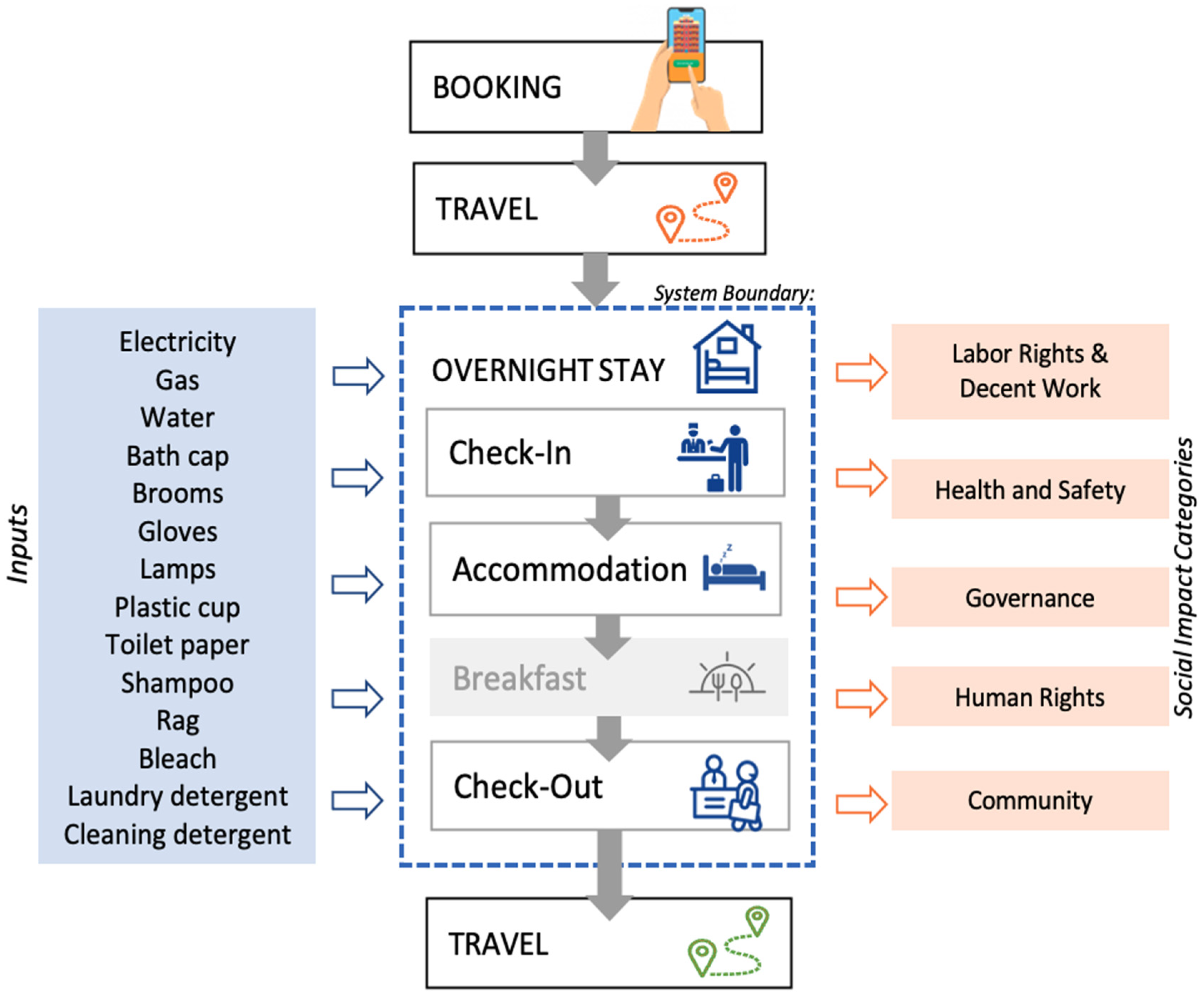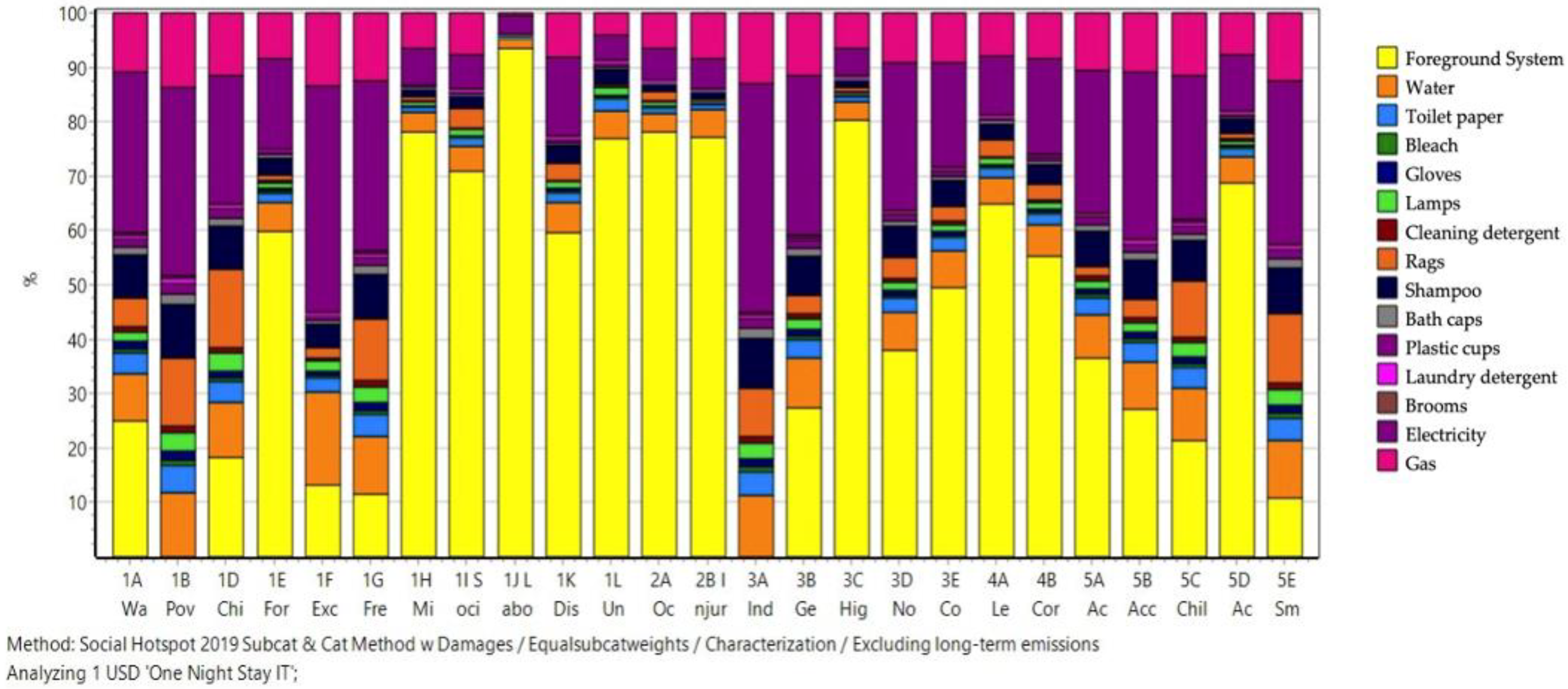Tourism Sector: The Supply Chain Social Footprint of an Italian Accommodation Facility
Abstract
1. Introduction
2. Materials and Methods
2.1. Goal and Scope Definition
2.2. Life Cycle Inventory
3. Social Footprint Results
4. Discussion
5. Conclusions
Author Contributions
Funding
Institutional Review Board Statement
Informed Consent Statement
Data Availability Statement
Conflicts of Interest
References
- Statista. Travel, Tourism & Hospitality–Number of International Tourist Arrivals Worldwide from 1950 to 2021 (in Millions). Available online: https://www.statista.com/statistics/209334/total-number-of-international-tourist-arrivals (accessed on 2 March 2022).
- UNWTO. World Tourism Barometer and Statistical Annex; World Tourism Organization: Madrid, Spain, 2023; Volume 21. [Google Scholar]
- Cocco, V. COVID-19: Any Future Perspectives for Tourism in Italy? Almatourism-J. Tour. Cult. Terr. Dev. 2020, 11, 61–74. [Google Scholar]
- Provenzano, D.; Volo, S. Tourism recovery amid COVID-19: The case of Lombardy, Italy. Tour Econ. 2022, 28, 110–130. [Google Scholar] [CrossRef]
- Bank of Italy. Tavole Dati Turismo (Tourism Data Tables). Available online: https://www.bancaditalia.it/statistiche/tematiche/rapporti-estero/turismo-internazionale/tavole/index.html?dotcache=refresh (accessed on 3 March 2023). (In Italian).
- Della Corte, V.; Doria, C.; Oddo, G. The impact of COVID-19 on international tourism flows to Italy: Evidence from mobile phone data. World Econ. 2023, 46, 1378–1407. [Google Scholar] [CrossRef] [PubMed]
- Arzoumanidis, I.; Walker, A.M.; Petti, L.; Raggi, A. Life Cycle-Based Sustainability and Circularity Indicators for the Tourism Industry: A Literature Review. Sustainability 2021, 13, 11853. [Google Scholar] [CrossRef]
- Italian Ministry of Tourism. Investimento-Fondi Integrati per la Competitività Delle Imprese (M1C3-I.4.2). Available online: https://www.ministeroturismo.gov.it/wp-content/uploads/2021/07/PNRR-scheda-Fondi-integrati-competitivita%CC%80-imprese.pdf (accessed on 2 March 2023). (In Italian)
- Jones, P.; Comfort, D. The COVID-19 crisis and sustainability in the hospitality industry. Int. J. Contemp. Hosp. 2020, 32, 3037–3050. [Google Scholar] [CrossRef]
- Kostilníková, K.; Matlovičová, K.; Demková, M.; Mocák, P.; Mishra, P.K.; Bujdosó, Z.; Matlovič, R.; Zawilińska, B. Slow Travel in Tourism—An outline of conceptual frameworks: Potential and limits in the context of post-pandemic recovery. Geo. J. Tour. Geosites 2022, 42, 751–758. [Google Scholar] [CrossRef]
- European Commission. Communication from the Commission-Agenda for a Sustainable and Competitive European Tourism (COM(2007) 621 Final). Available online: https://eur-lex.europa.eu/LexUriServ/LexUriServ.do?uri=COM:2007:0621:FIN:EN:PDF (accessed on 23 March 2023).
- European Commission. Sustainable Cultural Tourism. Available online: https://culture.ec.europa.eu/cultural-heritage/cultural-heritage-in-eu-policies/sustainable-cultural-tourism (accessed on 23 February 2023).
- UNEP (United Nations Environment Programme). Guidelines for Social Life Cycle Assessment of Products and Organizations 2020; Norris, C.B., Traverso, M., Neugebauer, S., Ekener, E., Schaubroeck, T., Garrido, S.R., Berger, M., Valdivia, S., Lehmann, A., Finkbeiner, M., et al., Eds.; United Nations Environment Programme (UNEP): Nairobi, Kenya, 2020. [Google Scholar]
- Benoît Norris, C.; Cavan, D.A.; Norris, G. Identifying social impacts in product supply chains: Overview and application of the social hotspot database. Sustainability 2012, 4, 1946–1965. [Google Scholar] [CrossRef]
- Ciroth, A.; Eisfeldt, F. PSILCA—A Product Social Impact Life Cycle Assessment Database; Database Version 1.0; GreenDelta: Berlin, Germany, 2016. [Google Scholar]
- Ramos Huarachi, D.A.; Piekarski, C.M.; Puglieri, F.N.; de Francisco, A.C. Past and future of Social Life Cycle Assessment: Historical evolution and research trends. J. Clean. Prod. 2020, 264, 121506. [Google Scholar] [CrossRef]
- Benoît Norris, C.; Bennema, M.; Norris, G. The Social Hotspots Database. Supporting Documentation. Update 2018 (V.4); New Earth B: New York, NY, USA, 2018. [Google Scholar]
- Huertas-Valdivia, I.; Ferrari, A.M.; Settembre-Blundo, D.; García-Muiña, F.E. Social Life-Cycle Assessment: A review by bibliometric analysis. Sustainability 2020, 12, 6211. [Google Scholar] [CrossRef]
- Arcese, G.; Lucchetti, M.C.; Merli, R. Social Life Cycle Assessment as management tool: Methodology for application in tourism. Sustainability 2013, 5, 3275–3287. [Google Scholar] [CrossRef]
- Arzoumanidis, I.; D’Eusanio, M.; Albu, A.; Raggi, A.; Petti, L. Valutazione dei rischi sociali della supply chain di una struttura ricettiva rumena (Assessment of the social risks of the supply chain of a Romanian accommodation facility). In Proceedings of the 16th Italian LCA Network Association Conference “La Sostenibilità nel Contesto del PNRR: Il Contributo Della Life Cycle Assessment”, Palermo, Italy, 22–24 June 2022; pp. 494–500. (In Italian). [Google Scholar]
- ISO 14040:2006; Environmental Management—Life Cycle Assessment—Principles and Framework, 2nd ed. International Organisation for Standardisation: Geneva, Switzerland, 2006.
- ISO 14044:2006; Environmental Management—Life Cycle Assessment Requirements and Guidelines. International Organisation for Standardisation: Geneva, Switzerland, 2006.
- United Nations Environment Programme-Society of Environmental Toxicology and Chemistry. Guidelines for Social Life Cycle Assessment of Products; United Nations Environment Programme: Paris, France, 2009. [Google Scholar]
- Tragnone, B.M.; D’Eusanio, M.; Petti, L. The count of what counts in the agri-food Social Life Cycle Assessment. J. Clean. Prod. 2022, 354, 131624. [Google Scholar] [CrossRef]
- Sanchez Ramirez, P.K.; Petti, L.; Haberland, N.T.; Ugaya, C.M.L. Subcategory Assessment Method for Social Life Cycle Assessment. Part 1: Methodological Framework. Int. J. Life Cycle Assess 2014, 19, 1515–1523. [Google Scholar] [CrossRef]
- Goedkoop, M.J.; de Beer, I.M.; Harmens, R.; Saling, P.; Morris, D.; Florea, A.; Hettinger, A.L.; Indrane, D.; Visser, D.; Morao, A.; et al. Product Social Impact Assessment Handbook-2020; PRé Sustainability: Amersfoort, The Netherlands, 2020. [Google Scholar]
- Benoit Norris, C.; Norris, G.A.; Azuero, L.; Pflueger, J. Creating Social Handprints: Method and Case Study in the Electronic Computer Manufacturing Industry. Resources 2019, 8, 176. [Google Scholar] [CrossRef]
- Italian National Institute of Statistics (ISTAT). Classificazione dei Comuni in Base Alla Densità Turistica (Classification of Municipalities Based on Tourists’ Density). Available online: https://www.istat.it/it/archivio/247191 (accessed on 21 March 2023). (In Italian).
- Sustainability Software for Fact-Based Decisions. Available online: https://www.pre-sustainability.com/sustainability-consulting/sustainable-practices/custom-sustainability-software (accessed on 25 March 2023).
- The World Bank. Children Out Of School (% of Primary School Age)–Romania. Available online: https://data.worldbank.org/indicator/SE.PRM.UNER.ZS?locations=RO (accessed on 25 March 2023).
- Bossetti, C.; Traini, E.; Alam, T.; Allen, C.A.; Carreras, G.; Compton, K.; Fitzmaurice, C.; Force, L.M.; Gallus, S.; Gorini, G.; et al. National burden of cancer in Italy, 1990–2017: A systematic analysis for the global burden of disease study 2017. Sci. Rep. 2020, 10, 22099. [Google Scholar] [CrossRef] [PubMed]
- Giraudo, M.; Bena, A.; Mosca, M.; Farina, E.; Leombruni, R.; Costa, G. Differences in work injury risk between immigrants and natives: Changes since the economic recession in Italy. BMC Public Health 2019, 19, 836. [Google Scholar] [CrossRef] [PubMed]
- Italian National Institute for Insurance against Accidents at Work. Infortuni e Malattie Professionali, Il Turismo al Centro del Nuovo Numero di Dati Inail (Accidents and Occupational Diseases, Tourism at the Center of the New Issue of Inail Data). Available online: www.inail.it/cs/internet/comunicazione/news-ed-eventi/news/news-dati-inail-turismo-2022.html (accessed on 9 March 2023). (In Italian).
- Transparency International. Corruption Perceptions Index. 2015. Available online: https://www.transparency.org/en/cpi/2019/index/ita (accessed on 27 March 2023).
- World Justice Project: Rule of Law Index 2021. Available online: https://worldjusticeproject.org/sites/default/files/documents/WJP-INDEX-2021.pdf (accessed on 20 March 2023).
- The Global Economy. Rule of Law–Country Rankings. Available online: https://www.theglobaleconomy.com/rankings/wb_ruleoflaw/ (accessed on 21 March 2023).
- D’Eusanio, M.; Serreli, M.; Petti, L. Social Life-Cycle Assessment of a Piece of Jewellery. Emphasis on the Local Community. Resources 2019, 8, 158. [Google Scholar] [CrossRef]
- UNEP. Methodological Sheets for Subcategories in Social Life Cycle Assessment (S-LCA); Traverso, M., Valdivia, S., Luthin, A., Roche, L., Arcese, G., Neugebauer, S., Petti, L., D’Eusanio, M., Tragnone, B.M., Mankaa, R., et al., Eds.; United Nations Environment Programme (UNEP): Nairobi, Kenya, 2021. [Google Scholar]
- Global Reporting Initiative G4 Sustainability Reporting Guidelines 2013 (Amsterdam, The Netherlands). Available online: https://respect.international/g4-sustainability-reporting-guidelines-implementation-manual/ (accessed on 21 May 2023).
- ISO 26000:2010; Guidance on Social Sustainability. International Organisation for Standardisation: Geneva, Switzerland, 2010.
- SA8000; The SA8000 Standard. Social Accountability International (SAI): New York, NY, USA, 2014.
- AA1000; AccountAbility: Assurance Standard. Accountability: London, UK, 2008.





| Impact Categories | Impact Subcategories |
|---|---|
| 1 Labour Rights and Decent Work | 1A Wage Assessment |
| 1B Poverty | |
| 1D Child Labour | |
| 1E Forced Labour | |
| 1F Excessive Overtime | |
| 1G Freedom of Association, Collective Bargaining and Right to Strike | |
| 1H Migrant Workers | |
| 1I Social Benefits | |
| 1J Labour Laws and Conventions | |
| 1K Discrimination and Equal Opportunities | |
| 1L Unemployment | |
| 2 Health and Safety | 2A Occupational Toxics and Hazards |
| 2B Occupational Injuries and Deaths | |
| 3 Human Rights | 3A Indigenous Rights |
| 3B Gender Equity | |
| 3C High Conflict | |
| 3D Human Health, Non-Communicable and Health Issues | |
| 3E Human Health, Communicable Diseases | |
| 4 Governance | 4A Legal System |
| 4B Corruption | |
| 5 Community | 5A Access to Improved Drinking Water Sources |
| 5B Access to Improved Sanitation | |
| 5C Children Out of School | |
| 5D Hospital Bed Access | |
| 5E Smallholder vs. Commercial Farms |
| Input | GTAP Sector and Country in SHDB | Functional Unit |
|---|---|---|
| Bath caps | Chemical, rubber, plastic products/ITALY | One overnight stay |
| Bleach | Chemical, rubber, plastic products/ITALY | |
| Brooms | Wood products/ITALY | |
| Cleaning detergents | Chemical, rubber, plastic products/ITALY | |
| Electricity | Electricity/ITALY | |
| Gas | Gas/ITALY | |
| Gloves | Chemical, rubber, plastic products/ITALY | |
| Lamps | Electronic equipment/ITALY | |
| Laundry detergents | Chemical, rubber, plastic products/ITALY | |
| Plastic cups | Chemical, rubber, plastic products/ITALY | |
| Rags | Textiles/CHINA | |
| Shampoo | Chemical, rubber, plastic products/ITALY | |
| Toilet paper | Paper products, publishing/ITALY | |
| Water | Water/ITALY |
Disclaimer/Publisher’s Note: The statements, opinions and data contained in all publications are solely those of the individual author(s) and contributor(s) and not of MDPI and/or the editor(s). MDPI and/or the editor(s) disclaim responsibility for any injury to people or property resulting from any ideas, methods, instructions or products referred to in the content. |
© 2023 by the authors. Licensee MDPI, Basel, Switzerland. This article is an open access article distributed under the terms and conditions of the Creative Commons Attribution (CC BY) license (https://creativecommons.org/licenses/by/4.0/).
Share and Cite
Arzoumanidis, I.; D’Eusanio, M. Tourism Sector: The Supply Chain Social Footprint of an Italian Accommodation Facility. Sustainability 2023, 15, 9793. https://doi.org/10.3390/su15129793
Arzoumanidis I, D’Eusanio M. Tourism Sector: The Supply Chain Social Footprint of an Italian Accommodation Facility. Sustainability. 2023; 15(12):9793. https://doi.org/10.3390/su15129793
Chicago/Turabian StyleArzoumanidis, Ioannis, and Manuela D’Eusanio. 2023. "Tourism Sector: The Supply Chain Social Footprint of an Italian Accommodation Facility" Sustainability 15, no. 12: 9793. https://doi.org/10.3390/su15129793
APA StyleArzoumanidis, I., & D’Eusanio, M. (2023). Tourism Sector: The Supply Chain Social Footprint of an Italian Accommodation Facility. Sustainability, 15(12), 9793. https://doi.org/10.3390/su15129793








